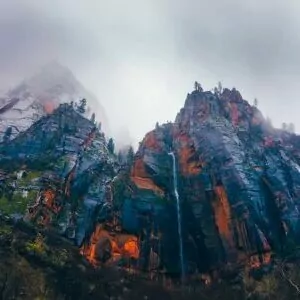Visiting Zion in January
Learn all about what to expect visiting Zion National Park in January
Updated: 10/06/22
Zion National Park sees just under 4.5 million visitors annually, and it may be hard to imagine peace and serenity in the park. But then winter comes along, and visitors get to experience the solitude and majesty of the park without the hustle and bustle of the summer crowds. Visiting Zion National Park in January allows you to breathe in the fresh and crisp winter air, see incredible landscapes dusted with snow, and have space to enjoy it fully. If you can make it to Zion in January, you will have a fantastic experience and leave with an appreciation for the beauty and solitude of winter in the park.

Benefits of Visiting Zion in January
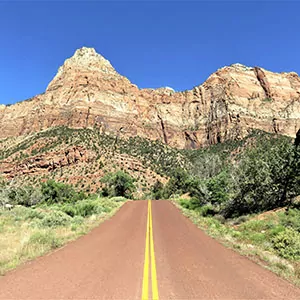 The lack of crowds is the most significant benefit of visiting Zion in January. Anyone who has visited Zion in the summer knows the crowds’ intensity and the trails’ popularity. In winter, it changes, and you can experience the park entirely differently. With fewer people, you can better appreciate the magnitude of the walls, the hushed nature of the canyons and rivers, and the wildlife that is more willing to be seen. Winter is a season of peace in Zion. Fewer crowds also mean better accommodation rates and availability. Zion accommodations in the park and just outside the park book months in advance in the summer, but in winter, you are more likely to find something last minute. You also won’t have to shell out peak-season accommodation prices.
The lack of crowds is the most significant benefit of visiting Zion in January. Anyone who has visited Zion in the summer knows the crowds’ intensity and the trails’ popularity. In winter, it changes, and you can experience the park entirely differently. With fewer people, you can better appreciate the magnitude of the walls, the hushed nature of the canyons and rivers, and the wildlife that is more willing to be seen. Winter is a season of peace in Zion. Fewer crowds also mean better accommodation rates and availability. Zion accommodations in the park and just outside the park book months in advance in the summer, but in winter, you are more likely to find something last minute. You also won’t have to shell out peak-season accommodation prices.
Another benefit of visiting in January is driving through the canyon with your car. Personal cars are not allowed past Canyon Junction from spring through fall unless you’re staying at the lodge. The only way to get around is to take the national park shuttle bus. While this is efficient and significantly mitigates the traffic in the park, it can be a hassle to deal with long lines, and you are limited to the bus schedules for when you have to leave and where you want to go. In January, personal cars are allowed through Zion Canyon.
The ability to drive yourself gives you the freedom to see what you want to see on your timeline. Take your time at the overlooks, hike some lesser-known trails, and drive slowly to look for wildlife on the canyon walls or crossing the roads. The walls and formations at higher elevations are often dusted with snow, and many of the waterfalls have icicles hanging around them. The higher water levels combined with, the fewer people make January an excellent time for photography. You may have to stay a few days to get those snow-dusted pictures in contrast to the red rocks, as snow isn’t as common as you might think and can often melt through the day. But there is truly nothing else like sunrise photography in Zion during the winter months. Make sure to get bundled up before you go out there, as it will be chilly, but you won’t regret breathing the crisp winter morning air among some of the most beautiful scenery you’ve ever seen.
Drawbacks of Visiting in January
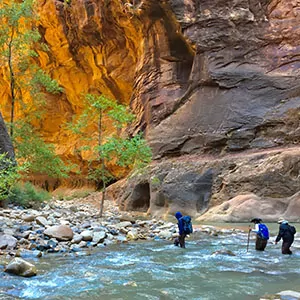 One of the most significant drawbacks of visiting Zion National Park in January is that while the roads are plowed after a winter storm, trails may be closed due to snow or ice. Some years, many of the trails remain covered in ice and inaccessible for much of the winter. While snow at lower elevations often melts within hours, it remains and accumulates at higher elevations. Despite the snow melting, the subfreezing temperatures at night can turn that runoff into ice, which is less fun and more dangerous. Trails with shade are often icy, and some trails are closed due to the danger of falling ice. Check out the trail conditions when planning what to do for the day, and stop by the visitor center to talk to a range for the most up-to-date information.
One of the most significant drawbacks of visiting Zion National Park in January is that while the roads are plowed after a winter storm, trails may be closed due to snow or ice. Some years, many of the trails remain covered in ice and inaccessible for much of the winter. While snow at lower elevations often melts within hours, it remains and accumulates at higher elevations. Despite the snow melting, the subfreezing temperatures at night can turn that runoff into ice, which is less fun and more dangerous. Trails with shade are often icy, and some trails are closed due to the danger of falling ice. Check out the trail conditions when planning what to do for the day, and stop by the visitor center to talk to a range for the most up-to-date information.
Traction devices such as microspikes or crampons are recommended for trails at higher elevations, as well as trails with shaded sections where snow and ice are less likely to melt. A related drawback to Zion in January is that the park can be very cold. Freezing temperatures at night and highs during the day in the low 50s can make visiting with little ones or elderly parents difficult. Camping is an option in Zion in winter, but you will need a four-season tent and a 0° sleeping bag.
Perhaps, if one of your main bucket list items for Zion is hiking and playing in the rivers, winter is not your time to visit. While you can still hike the Narrows, you will likely need a neoprene wetsuit or dry suit with insulating layers underneath to keep yourself warm. Water temperatures can be as low as 38° (nearly freezing!), and visitors should know the danger of falling ice. Submersion in cold water is the quickest way to contract hypothermia, which can be life-threatening if not warmed up.
Another danger of winter is the more significant potential for flash floods due to greater rainfall even miles away. Slot canyons are particularly susceptible, and visitors need to understand these floods’ dangers. Water can come rushing down the canyon in a wall of 12 feet or higher, bringing with it rocks, tree trunks, boulders, and other debris. Even 6 inches of water can be strong enough to knock you off your feet, and it is essential to understand the warning signs of change in water temperature or color, thunder and clouds gathering (even far away from you), and excess debris in the water.
Things To Do In January
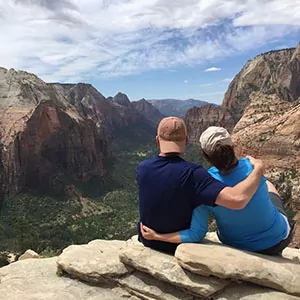 January is a great time to explore Zion without the crowds. The glistening snow in the canyon and on top of the towering cliffs makes the park very photography-friendly. Make sure to catch sunrise or sunset from Canyon Overlook Trail or Watchman Overlook Trail. Winter in Zion is terrific for sightseeing, especially since you can drive through the canyon in your car. Take your time at the overlooks and enjoy the scenery without the additional crowds. You will need to bundle up, especially if you are out in the morning or the evening, but it will be well worth it. If snow is in the forecast for overnight, get up as early as possible to get those pictures before it melts. Snow at lower elevations sometimes melts within hours of the sun coming up, so you will not want to miss your chance to capture the red-and-white contrast in your pictures. Snow at higher elevations doesn’t melt as fast and usually accumulates over winter, but due to inaccessible trails, you may not be able to reach these areas to take pictures.
January is a great time to explore Zion without the crowds. The glistening snow in the canyon and on top of the towering cliffs makes the park very photography-friendly. Make sure to catch sunrise or sunset from Canyon Overlook Trail or Watchman Overlook Trail. Winter in Zion is terrific for sightseeing, especially since you can drive through the canyon in your car. Take your time at the overlooks and enjoy the scenery without the additional crowds. You will need to bundle up, especially if you are out in the morning or the evening, but it will be well worth it. If snow is in the forecast for overnight, get up as early as possible to get those pictures before it melts. Snow at lower elevations sometimes melts within hours of the sun coming up, so you will not want to miss your chance to capture the red-and-white contrast in your pictures. Snow at higher elevations doesn’t melt as fast and usually accumulates over winter, but due to inaccessible trails, you may not be able to reach these areas to take pictures.
Another great activity in January is hiking. Many trails are open throughout the winter, giving you the space to enjoy the scenery without the crowds you’ll experience at other times of the year. You can read our list of Zion’s best trails for recommendations. The Riverwalk is an excellent option if you are looking to stroll along the Virgin River but don’t have the equipment to brave the cold water in the Narrows. This trail is primarily flat and takes you right up to where the Narrows Hike begins, giving you fantastic river views as the canyon walls get narrower and narrower the farther you hike.
Backpacking is an option in Zion, but the cold and snow will make it difficult in winter, and you should ensure you have the necessary winter camping experience to make your trip safe. Check with a ranger or the park website for more info on backpacking. Snowshoeing is also an excellent option for hiking on trails at higher elevations; many companies in Springdale rent snowshoes.
Wildlife viewing is an excellent activity in Zion during the winter months. You may have a chance to see large mammals such as bighorn sheep or deer concentrated in the valleys and canyons. The contrast of the animals against a snowy background is excellent for viewing and photography. Also, watch for larger predators that may hunt these concentrated animals, such as bobcats and mountain lions. Zion does have bears in the park, but they will be in hibernation this time of year to wait out the cold. Watch for wild turkeys, which travel in large flocks and often can be found walking very slowly across the road.
Suppose the weather turns for the worse, and you need some indoor activities to warm up. In that case, the visitor center has excellent interpretive exhibits and a 22 min park film that is informative and entertaining. The Zion Human History Museum is also a great option and has exhibits on Native American history, the effect that water has on the park, and much more.
Things to see in January
There are nearly as many things to see in Zion as there are to do, and if you read the previous section, you know that’s a lot. Sightseeing is one of the main activities in winter, especially if trails are closed, and you are mostly limited to the roads. Snow-covered cliffs, rushing rivers, half-frozen waterfalls, and even a flock of wild turkeys can all be wonderful to see in the park. Below, we’ve created a short list of some of the must-see sights in January in Zion, but make sure to do your own research to see what piques explicitly your interest in the park.
Emerald Pools: Three sets of pools– lower, middle, and upper– are aligned along an easy trail across the road from the Zion Historic Lodge. Beautifully colored and gathered from the dripping water overhead on slick rocks, these pools are iconic to Zion. The lower pools are on a wide, paved sidewalk and are wheelchair accessible (with assistance), and the trail to the middle pools is mostly the same, albeit with a little more incline. However, the trail to the uppermost pools is sandy and much steeper. Stop to see these beautiful features, with the lower pools only being a mile trek.
Kolob Canyons: The northern part of Zion national park, Kolob Canyons is truly a unique and majestic area, framed with spectacular red rock canyons. While it might be closed in the winter due to ice and snow, double-check if the road and trails in this canyon are available, as this is a must-see area if you can get to it.
The Canyon Overlook: This overlook requires a relatively easy 1-mile hike, but it’s well worth it. Trek a little ways up the side of the canyon from the parking lot on Highway 9, rest in the shade of the hidden cave if you like, and then journey up to the overlook, where you will have a fantastic vista of the entire canyon, brilliant red rocks, and the gorgeous tree line. If you’re lucky, snow will be topping the mountains this time of year, so make sure not to miss this stunning view.
Wildlife: Zion National Park is unique to any other place in the world and has remarkable biodiversity. If you visit Zion in January, take some time to see wildlife in the park. Bald eagles, golden eagles, and condors are only a few birds you might see, and the snow at higher elevations will cause deer and bighorn sheep to congregate in the canyon. Get your camera ready for these fantastic creatures, and ask a ranger if you want to see something specific.
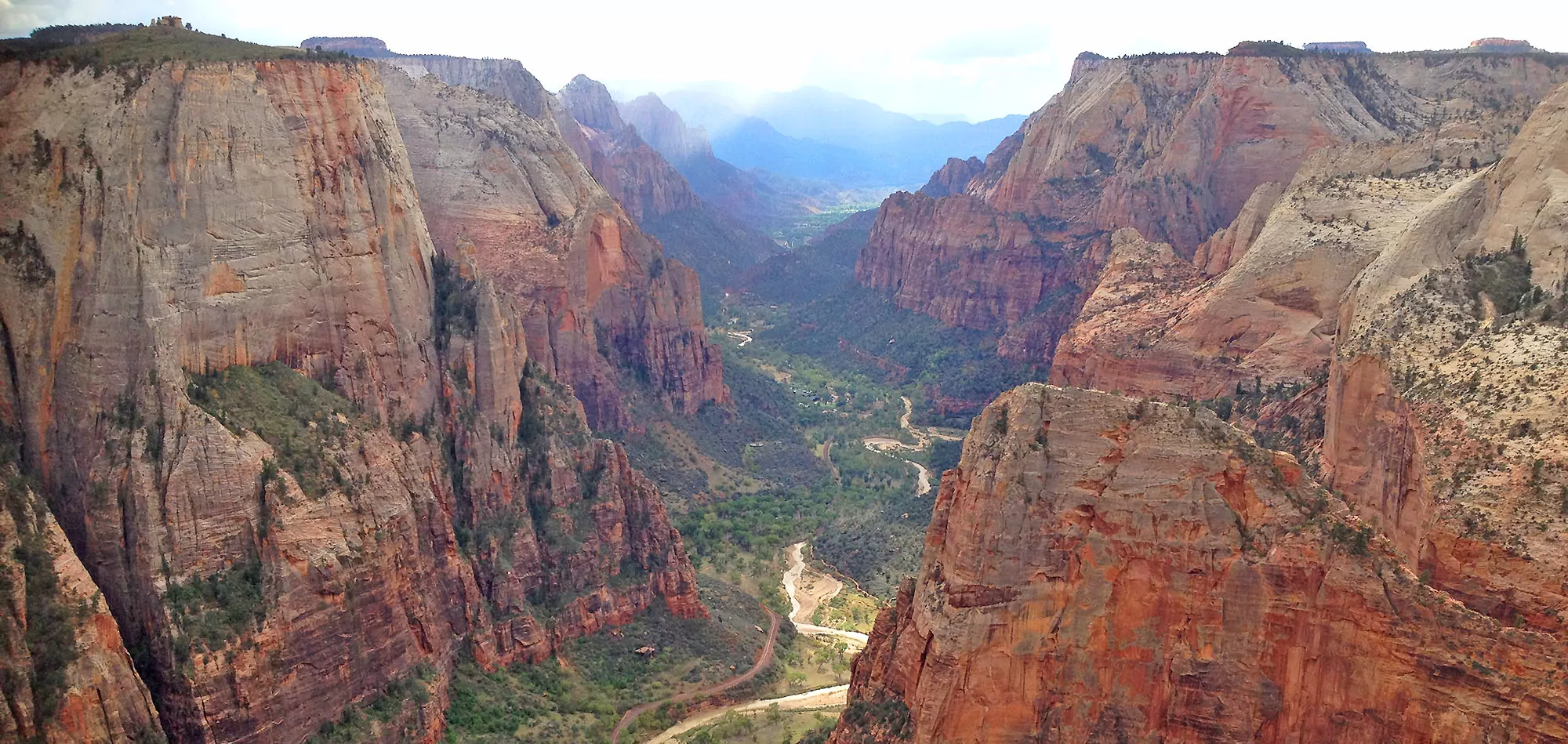
Hiking in January
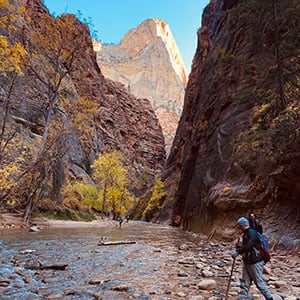 Hiking is a great winter activity because the crowds have thinned so immensely and you are more likely to have the trail to yourself. While roads are plowed during the winter months, some hiking trails may be closed due to snow or ice. Which trails are closed and when they will be closed will depend on the year and the snowfall. You can stop by the visitor center to ask a ranger or read the current conditions online for up-to-date information. Do not attempt to hike a trail that is closed for ice and snow, even if there is no ice or snow on the ground. Many of the trails are closed due to the risk of falling ice, which is oftentimes much more dangerous than ice on the ground. Beware of shady spots on trails that are otherwise free of ice and watch for increased ice and snow as you go higher in elevation.
Hiking is a great winter activity because the crowds have thinned so immensely and you are more likely to have the trail to yourself. While roads are plowed during the winter months, some hiking trails may be closed due to snow or ice. Which trails are closed and when they will be closed will depend on the year and the snowfall. You can stop by the visitor center to ask a ranger or read the current conditions online for up-to-date information. Do not attempt to hike a trail that is closed for ice and snow, even if there is no ice or snow on the ground. Many of the trails are closed due to the risk of falling ice, which is oftentimes much more dangerous than ice on the ground. Beware of shady spots on trails that are otherwise free of ice and watch for increased ice and snow as you go higher in elevation.
There are a multitude of hiking trails in Zion with a full range of accessible to strenuous routes. The Riverwalk is an excellent option for those looking to hike along the river but doesn’t have the equipment to brave the chilly waters of the Narrows in the winter. This hike takes you along the Virgin River to where the Narrows begin. It is primarily flat and gives you a taste of a slot canyon as the walls get narrower and narrow or as you hike. Hiking the Narrows in the Virgin River is possible in winter, but you will need a neoprene wet suit or a dry suit with warm layers underneath to keep warm. The water can be as cold as 38° F, and immersion in cold water is the quickest way to contract hypothermia. Depending on precipitation throughout the Colorado plateau, there can be places in the Narrows where you have to swim and thus wholly submerge yourself in frigid water. This can be incredibly dangerous, and visitors should use caution. We do not recommend doing this winter hike unless you are experienced. If you want to hike the Narrows, it’s best to come in summer when the temperature is warm, and the water is refreshing, if cold on your feet.
Emerald pools and the Canyon Overlook Trail are other terrific options for more accessible hikes, with the latter being slightly steeper than the former. Perhaps the most famous hike in the park is Scout Lookout leading up to Angels Landing. The trail up to Scout Lookout is fairly moderate, and this point provides you with great views of the canyon. The last section of the hike to Angels Landing is very steep, very narrow, and has incredible height exposure, with the last climb– called the spine– often having to be done on all fours gripping the small ridge of rock. If this sounds intimidating during regular weather, you can imagine how nerve-racking and dangerous it is when there is ice and snow. Many steep steps can become ice walls, with one slip sending you off the cliff. If you’re not sure what the conditions will be, the hike to Scout Lookout can be done in most conditions as long as you have traction devices on your boots. From there, you can see some of what the trail looks like. Visitors are advised to use extreme caution and always check with the ranger to see the conditions.
Early mornings will be chilly in Zion, so start with many layers, including hats and gloves. Even though it’s cold outside, drink plenty of water throughout the day; taking at least three liters with you is recommended. Remember that the sun sets early during the winter, so make sure you set out with enough time to finish your hike before the sun goes down. An excellent option for hiking in January is an inn-based tour, where you will experience the best of Zion and Bryce Canyon on day hikes with a local and knowledgeable guide and enjoy evenings at your warm and cozy lodge. These trips take care of all the planning, accommodations, and meals, so you can enjoy your vacation without the stress of planning a National Park trip.
backpacking in january
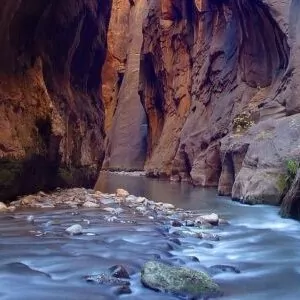 Zion is a world-renowned backpacking destination, but spending multiple nights in the backcountry can be an extreme environment and dangerous. Zion has different regulations than other national parks, with stricter limits on group size, camping locations, and wilderness-human impact. Most areas in the park you can backpack to have designated sites you must camp in. A backpacking trip through the Narrows is possible, and there are 12 designated sites along the canyon. Kolob Arch via La Verkin Creek Trail is an excellent option if Kolob Canyon is accessible. Talk to a ranger or others who have backpacked independently for more Trail recommendations for the park. Zion has a pack-it-in, pack-it-out rule that includes all trash and human waste. Backpacking on any of these trails in winter will be more difficult, especially on the ones at higher elevations that are likely to have ice and snow. Crampons or microspikes are a must, as a four-season tent and a 0° sleeping bag. Hiking in the winter is no joke, and the desert environment in Zion can be very unforgiving. Freezing temperatures, lack of drinkable water, dangers from wildlife, and ice and snow can all cause problems for the backpack.
Zion is a world-renowned backpacking destination, but spending multiple nights in the backcountry can be an extreme environment and dangerous. Zion has different regulations than other national parks, with stricter limits on group size, camping locations, and wilderness-human impact. Most areas in the park you can backpack to have designated sites you must camp in. A backpacking trip through the Narrows is possible, and there are 12 designated sites along the canyon. Kolob Arch via La Verkin Creek Trail is an excellent option if Kolob Canyon is accessible. Talk to a ranger or others who have backpacked independently for more Trail recommendations for the park. Zion has a pack-it-in, pack-it-out rule that includes all trash and human waste. Backpacking on any of these trails in winter will be more difficult, especially on the ones at higher elevations that are likely to have ice and snow. Crampons or microspikes are a must, as a four-season tent and a 0° sleeping bag. Hiking in the winter is no joke, and the desert environment in Zion can be very unforgiving. Freezing temperatures, lack of drinkable water, dangers from wildlife, and ice and snow can all cause problems for the backpack.
It is very important that those thinking about backpacking in the park know the dangers they might encounter and how to deal with them. Hypothermia is one of the biggest dangers, especially if you are hiking the Narrows in the Virgin River. Hypothermia can lead to death if not treated, and you can contract it when the temperature is above freezing. Look for symptoms of the “umbles,” stumbling, mumbling, fumbling, and grumbling. The best way to avoid this condition is to put on your warm clothes before you start shivering and your rain gear before you get wet. If you’re hiking in the Narrows, have dry clothes in a dry bag ready to put on immediately when your hike is done, and avoid extended periods out of the water in wet clothes. No campfires are allowed anywhere in the park, so you cannot rely on fire to warm you back up.
All hikers, but especially backpackers, need to be aware of the dangers of cyanobacteria that may be present in the park’s water sources. There has been a recent bloom in cyanotoxins at the time of writing, especially in the Virgin River. Exposure to this toxin through ingesting water or an opening in the skin can lead to severe illness and death. Cyanobacteria toxin can be contracted by recreating in the water or drinking it. No commercial filtration method is known to remove the pathogen. Always get water directly from springs and not from rivers or creeks where the toxic bacteria is likely to have grown. You can read more about backpacking regulations and safety in Zion on the park’s website.
Weather in January
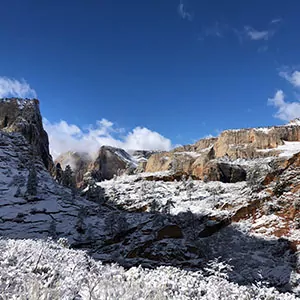 Zion is a large park, and the weather you experience will vary greatly depending on your location and your elevation. Despite being a desert, Zion receives a good amount of precipitation in the winter and the summer monsoon season. As one of the steps in the drainage of the Colorado Plateau, Zion receives much of its water from the Virgin River that flows south through the park. Thus, the weather outside the park, often far north of it, can significantly affect weather conditions in the park, such as flash floods and water temperature. Weather in Zion during January is typically cold and wet. The average temperature for Zion Canyon is a high of 52 and a low of 29 degrees Fahrenheit (11/-1 degrees Celsius). In Kolob Canyons, the average temperature is a high of 52 and a low of 27 degrees Fahrenheit (11/-2 degrees Celsius). On average, it rains or snows seven days in January. Notice that it rains or snows in January.
Zion is a large park, and the weather you experience will vary greatly depending on your location and your elevation. Despite being a desert, Zion receives a good amount of precipitation in the winter and the summer monsoon season. As one of the steps in the drainage of the Colorado Plateau, Zion receives much of its water from the Virgin River that flows south through the park. Thus, the weather outside the park, often far north of it, can significantly affect weather conditions in the park, such as flash floods and water temperature. Weather in Zion during January is typically cold and wet. The average temperature for Zion Canyon is a high of 52 and a low of 29 degrees Fahrenheit (11/-1 degrees Celsius). In Kolob Canyons, the average temperature is a high of 52 and a low of 27 degrees Fahrenheit (11/-2 degrees Celsius). On average, it rains or snows seven days in January. Notice that it rains or snows in January.
Never attempt to hike any closed trails due to ice and snow, even if there is no ice or snow on the trail. If the trail goes up in elevation, there is likely ice and snow further up; trails are also sometimes closed due to the danger of falling ice which can be much more dangerous than ice on the ground. Microspikes or crampons are a must in January for hiking, as black ice or ice in shady sections of trails can catch visitors off guard. You are not likely to encounter a snowstorm or become snowed in Zion because the snow often doesn’t stick around that long.
Wildlife in january
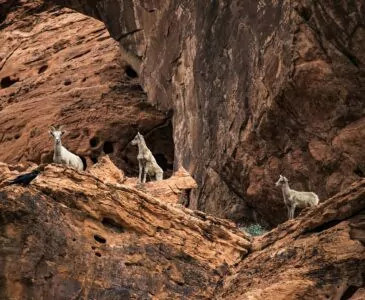 Wildlife in Zion National Park is abundant in January, perhaps unintuitively. Because of the colder temperatures and the snow on the mountains, many animals come down and congregate in the valleys and canyons. Mule deer, bighorn, and sheep are more concentrated in the lower elevations. This phenomenon, coupled with the lack of crowds and traffic, makes viewing these animals much easier and more peaceful. What you will see depends mainly on what time of day you look.
Wildlife in Zion National Park is abundant in January, perhaps unintuitively. Because of the colder temperatures and the snow on the mountains, many animals come down and congregate in the valleys and canyons. Mule deer, bighorn, and sheep are more concentrated in the lower elevations. This phenomenon, coupled with the lack of crowds and traffic, makes viewing these animals much easier and more peaceful. What you will see depends mainly on what time of day you look.
During the day, you’ll likely see mule deer, rock squirrels, and maybe a coyote along the road. You may also catch a glimpse of bighorn sheep which prefer high, rocky areas and blend in perfectly with the cliffs. Zion has few bears, so each sighting should be reported to a park ranger. There is a small chance of seeing them in winter, as they will hibernate wherever they are. Bats are also a common wildlife sighting, especially at dawn and dusk.
The park is home to many species which are difficult to identify as they fly around quickly. At night, if you’re walking around with a flashlight or driving on the roads, you might catch the eye shine of a gray or red fox. Coyotes are also common to see and hear at night, and if you’re lucky, you may catch some of the elusive movements of a ringtail cat. Although it is closely related to the raccoon and not a cat, this strictly nocturnal animal is often described as “the cutest animal you’ve never seen” due to its elusive habits.
Zion also has a population of California condors, the largest bird native to North America. With a wingspan reaching up to 9 1/2 feet, these birds are truly majestic to see and are critical scavengers. They can often be seen riding updrafts of warm air from the canyons up to higher elevations, so break out your binoculars and see if you can find any of these majestic birds. If you’re interested in seeing something specific, ask a ranger where the best place and time of day would be.
REcommended wildland trips in january
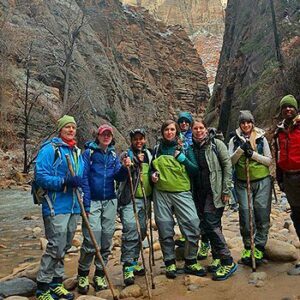 Planning a trip to Zion in January can be a headache as you try to keep up with current conditions, what trails and roads are open, and what the weather will be while you’re there. Making your itinerary, packing list, and planning your meals can be a headache on a trip to a place as remote as Zion. Bypass the headache by booking a trip with Wildland Trekking. We offer hiking tours in various styles, one of which is sure to fit the vacation you were thinking of. Whether you want to camp with us, stay at a lodge on an inn-based tour, or spend a day with one of our expert guides, we have something for you. Feel free to check out all the trips we offer in Zion or read on for a few we especially recommend for January.
Planning a trip to Zion in January can be a headache as you try to keep up with current conditions, what trails and roads are open, and what the weather will be while you’re there. Making your itinerary, packing list, and planning your meals can be a headache on a trip to a place as remote as Zion. Bypass the headache by booking a trip with Wildland Trekking. We offer hiking tours in various styles, one of which is sure to fit the vacation you were thinking of. Whether you want to camp with us, stay at a lodge on an inn-based tour, or spend a day with one of our expert guides, we have something for you. Feel free to check out all the trips we offer in Zion or read on for a few we especially recommend for January.
Zion and Bryce 4-Day Tour: Experience the best of both Zion and Bryce Canyon without the crowds on this 4-day tour in January. See the Narrows, hike around the hoodoos, experience the panoramic views of both parks and feel safe in the hands of one of our expert guides. All-inclusive with your meals, accommodations, much of your hiking gear, and local transportation included, you won’t want to miss out on this fantastic western adventure.
Snow Canyon Private Day Hike: Explore the wonders of “mini Zion Canyon” in Snow Canyon on this daytime tour. See this fantastic canyon and its remarkable lava flows in the heart of Zion’s red rock canyon. With top-of-the-line backpacks and trekking poles included along with trail snacks and a picnic lunch, this hike is one you won’t want to miss as the area is remote, and your expert local guide will be able to show you around the remarkable scenery.
Zion in a Day Private Tour: If you only have one day to spend in Zion and want to ensure you hit all the high points, this trip is for you. You can expect to embark on 3 or 4 short day hikes in distinct areas of the park interspersed by a picnic lunch, tasty snacks, and opportunities to learn about the history and culture of the region. The Temple of Sinawava, the Narrows, the Virgin River, Emerald Pools, and the Watchman trail all in one day is quite the feat, but you won’t be sorry you saw it all in only one day in the park.
Join a Guided Hiking Adventure
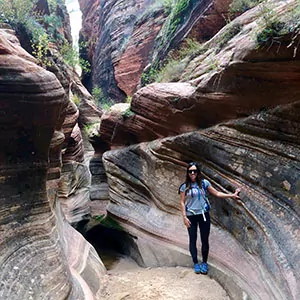 Zion National Park is home to some of the world’s most epic and fantastic hiking vacations. Wildland Trekking offers trips with the best of Zion: canyons, views, wildlife, solitude, adventure, and fascinating natural and cultural interpretation.
Zion National Park is home to some of the world’s most epic and fantastic hiking vacations. Wildland Trekking offers trips with the best of Zion: canyons, views, wildlife, solitude, adventure, and fascinating natural and cultural interpretation.
Guided Zion treks are all-inclusive, which covers permits; local transportation (excluded on specific tours); meals; equipment; safety systems, and professional hiking/wilderness guides, allowing visitors to maximize their time in Zion and focus entirely on enjoying the Park.
ZION ADVENTURE TOURS
- INN-BASED HIKING PACKAGES: these tours are all-inclusive packages with lodging, amazing daily hikes, expert guides, meals, transportation, and more!
- ZION CAMPING TOURS: camping-based hiking packages provide all-around hiking experiences of Zion on wonderful outdoor vacations.
- ZION DAY HIKE TOURS: maximize your day in Zion on a fully guided, award-winning hiking tour on one of the Park’s best trails.
- ALL UTAH HIKING TOURS: check out a complete list of Utah offerings, which include Bryce Canyon, the North Rim, Arches, Canyonlands, and more.
- UTAH BACKPACKING TRIPS: explore options for discovering Utah on an all-inclusive backpacking trip with expert guides and mind-blowing scenery.





